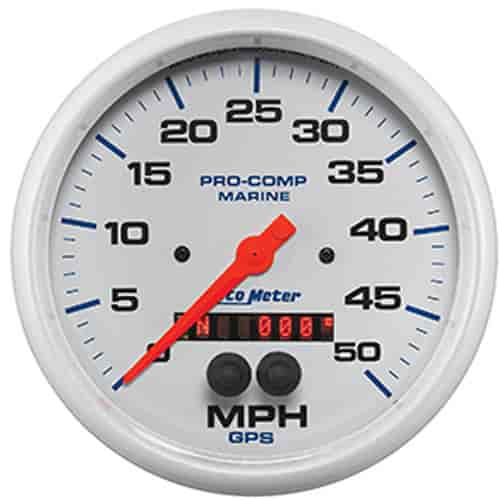
Whether it's a 5-knot sailboat or a knot racer, the obsession with speed is pervasive. Accurately measuring the speed of a boat is a complex problem, but most of the hard work has already been done by instrument manufacturers- all that's left for the boat owner to do is to install a handful of parts, get out on the water, and start competing for every extra knot of speed.
Find a suitable spot on the boat's instrument panel. Drill a hole in the panel, insert the GPS speedometer, and secure its mounting bracket on the back of the panel as described in the speedometer's manual. Locate suitable sources of volt power.
On most boats, the existing instruments are connected to suitable power buses that the speedometer can share. Crimp terminal fittings onto the ends of the speedometer's power wires and connect these to the ground and power buses. The GPS speedometer should now be ready to use. Mount the speedometer display and connect its backlight to a power source, in the same manner as for GPS speedometers. Find a suitable route for the pressure tube. The display will be connected to the pitot by a thin, stiff tube that transfers the water pressure at the pitot to the sensor in the display.
- Sign up to receive the latest tips, promotions and news from Mercury.
- asian and black interracial dating.
- dating divas valentine printables.
- how to stay safe online dating.
- Yamaha Fuel management/Speedometer GPS hookup.
- xtranormal black dating.
- Engine Instrument Wiring Made Easy.
The tube has to slope downward toward the transom at all points; if there are sags in the tube, water can collect inside it and mess up the instrument's readings. A second gauge group consists of voltmeters and ammeters, and they work a bit differently. With older gauges, an ammeter will typically get connected up via what we call a shunt in a series electrical connection. Voltmeters will often be found instead of or in addition to ammeters. These get connected in parallel with one DC positive wire and one DC negative wire supplying power to the gauge and enabling a voltage measurement.
Finally, the third category of instrument we need to look at briefly is the engine tachometer.
Boat Repair: Fixing the Speedometer
Tachometers are somewhat unique when it comes to the electrical connections to them. Besides the electrical connection points on the gauges, the ABYC has for many years had some recommended color codes for the various wires coming from the engine mounted sending units and fuel tank level gauge, as well as the DC positive and ground conductors involved.
Not all, but many of the engine manufacturers follow these color recommendations. Back Explore View All. Back Types View All. Unpowered Boats Kayaks Dinghies.
Fixing Speedometer Reading Issues - Mercury Dockline | Mercury Marine
Personal Watercraft Personal Watercraft. If you can't solder this, any radiator shop can. If you know a plumber, they can do it, too. I thought it might be some sort of reservoir. My last boat didn't have anything like that, and the speedo worked fine, from what I can remember Well, I'll have the boat out on Wednesday and see how it does. If I get needle bounce, I'll put the ballast back in the loop. Thanks for the replies.
Bonefish Made Easy
I have seen dual speedo boats with a ballast on each. What is needed is based on the gauge itself.
- liberal kansas dating.
- ;
- ;
- speed dating for seniors.
- Engine Instrument Wiring Made Easy - f.e-safety.com.ua.
- Yamaha Fuel management/Speedometer GPS hookup - The Hull Truth - Boating and Fishing Forum.
I never seen one ballast tube for 2 speedometers. I have one for each. I say if it is impossible to hook up behind the tank and you dont want to remove the tank, go ahead and bypass it for now and see how it works. Worst case, you will have to remove tank later. My dads old outboard never had one and had stable read outs.
Engine Wiring: Cable Ties
Sorry for the delayed conclusion I took the boat out and both speedometers work fine. The one with the ballast in-line rolls up to speed slower than the one without, but they both track accurately and neither bounce much. This also fixed the mysterious leak that I have had all season hole in the old pitot tube leaking into the back of the boat.